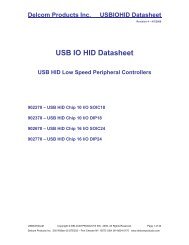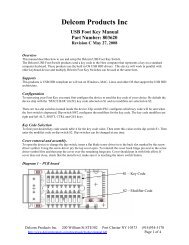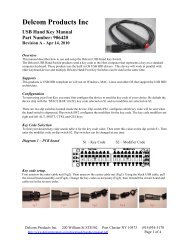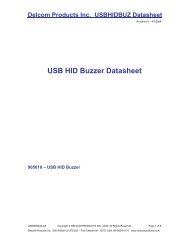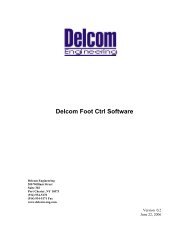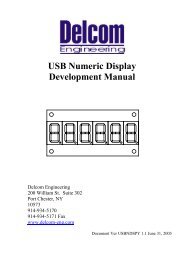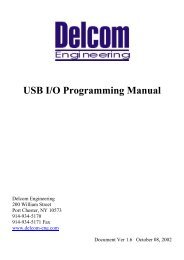You also want an ePaper? Increase the reach of your titles
YUMPU automatically turns print PDFs into web optimized ePapers that Google loves.
<strong>Delcom</strong> <strong>Products</strong> <strong>Inc</strong>.<br />
USBIOHID Datasheet<br />
Revision 8 – 04/12/2010<br />
6.4.6 Communication Commands<br />
MinorCmd = 50<br />
ExtData[0] = Length<br />
ExtData[1..7] = Data<br />
Length = 16 Bytes<br />
MinorCmd = 60<br />
LSBData = Add/Cmd(B0)<br />
MSBData = Length<br />
ExtData[0..7] = Data<br />
Length = 16 Bytes<br />
MinorCmd = 61<br />
LSBData = Add/Cmd(B0)<br />
MSBData = Address(B1)<br />
Length = 8 Bytes<br />
MinorCmd = 62<br />
LSBData = RdSelCmd(B2)<br />
MSBData = Length<br />
Length = 8 Bytes<br />
MinorCmd = 63<br />
LSBData = 0<br />
MSBData = Length<br />
HidData0 = Add/Cmd(B0)<br />
HidData1 = AddLSB(B1)<br />
HidData2 = AddMSB(B2)<br />
HidData3 =RdSelCmd(B2/3)<br />
Length = 8 Bytes<br />
MinorCmd = 70<br />
LSBData = On/Off<br />
MSBData = Length<br />
DataExt[0] = Repeat Value<br />
DataExt[1] = OnTime<br />
DataExt[2] = Off Time<br />
Length = 16 Bytes<br />
MinorCmd = 71<br />
LSBData = Mode<br />
Length = 8 Bytes<br />
50 - Writes to the RS232 Serial Port. This command sends data to the<br />
serial port. Both the data count and data are passed in the Data<br />
Extension. The MSB and LSB bytes should be zero. The data count is<br />
in the LSB byte (first byte of the DataExt) and the data is in the<br />
remaining 7 bytes. Issuing this command clears the TX Status register<br />
(see 11-9). Example command 8,18,0,0,6,5,1,2,3,4,5 will send 5 bytes<br />
of data (1,2,3,4,5) to the serial port.<br />
60 - Write to the I2C Port. This command writes the data found in the<br />
data extension to the I2C device. The device address/command is set<br />
in the Data LSB byte and the number of bytes to send is set in the Data<br />
MSB byte. If an error occurs bit 4/7 of byte 7 is set in the system<br />
parameters bytes, else reset. See read command 9.<br />
61 -I2C Selective Read Setup 1. Note this is an old command left for<br />
backwards compatibility with generation I chip sets. It is recommended<br />
that you use command 63 instead of this command.<br />
This commands setups the selective read command 61. You will also<br />
need to call command number 62 to setup the selective read. The Data<br />
LSB should be set to the device address/command (byte 0) and the<br />
Data MSB should be set to the selective read address (byte 1). Also<br />
see read command 61.<br />
62 -I2C Selective Read Setup 2. Note this is an old command left for<br />
backwards compatibility with generation I chip sets. It is recommended<br />
that you use command 63 instead of this command.<br />
This commands setups the selective read command 61. You will also<br />
need to call command number 61 to setup the selective read. The Data<br />
LSB should be set to the device read command (byte 2) and the Data<br />
MSB should be set to the read length. Also see read command 61.<br />
63 -I2C Selective Read Setup. This commands setups the selective<br />
read command 61. The Data LSB is not used and should be set to zero<br />
for future compatibility. The Data MSB is set to the read length in bytes.<br />
The HidData0 is set to the I2C device address/command (byte 0). The<br />
HidData1 is set to the LSB address of the I2C device. The HidData2 is<br />
set to the MSB address of the I2C device (byte 2), this byte is only sent<br />
in 16 bit mode. The HidData3 is set to the I2C read command this will<br />
be byte 2 or 3 depending on the mode used. Once this command has<br />
been sent the user should call the read 61 or 62 command.<br />
70 – Buzzer Control. This command is used to drive a buzzer on port 0<br />
pin3. See the buzzer control description for more information.<br />
71 – H-Bridge Control. This command is used to control the H-Bridge<br />
functions. The LSBData parameter configures the H-Bridge mode.<br />
Values: 0=Off, 1=State 1 (forward), 2=State 2(reverse),0xFF= Brake<br />
(both lower drivers are on). See H-Bridge description for more info.<br />
<strong>Inc</strong>luded in firmware version 25 and above.<br />
USBIOHID.pdf Copyright © DELCOM PRODUCTS INC. 2009. All Rights Reserved. Page 20 of 36<br />
<strong>Delcom</strong> <strong>Products</strong> <strong>Inc</strong>. 200 William St STE302 – Port Chester NY 10573 USA (914)934-5170 www.delcomproducts.com



